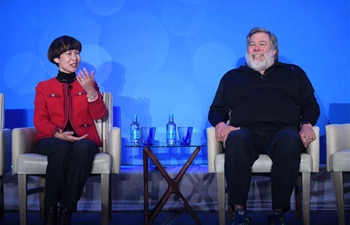by Xu Jing, Zhou Zhou, Miao Zhuang
CHICAGO, July 1 (Xinhua) -- Ian Jepson has worked for Syngenta for 29 years. As head of plant performance biology at Syngenta Research Triangle Park, North Carolina, he aims to develop crops that produce more yields in a sustainable way.
"The world's population increases 100,000 people every single day. We need to be able to feed those people in a sustainable way," he told Xinhua in an interview.
INCREASE CROP YIELD
Agricultural production in the world faces many challenges nowadays: insects, crop diseases and viruses. All these pose a big threat to the output of agricultural products.
"We have a number of projects using GMO (genetically modified organism) and non-GMO techniques to do that (increase crop yield)," Jepson said. By technology-rich aid technology, Jepson and his team are transferring insect resistance genes into the crops to stop the insects damaging the crop, then losing yield.
Jepson is also studying the impact of drought, heat and cold on crops.
Syngenta has an innovation center located in the Research Triangle Park in the U.S. state of North Carolina for Jepson and his team to do all these researches. The crop greenhouse facility here has many small chambers, with each chamber being controlled independently of the other in terms of temperature, humidity, and CO2, and underneath each room in the basement there are very advanced set of equipment for air conditioning, and humidity control, CO2 control.
"It's like an arms race. Biology will always adapt," Jepson said. When the first wave of technology was introduced, it protected the crops from certain insects and diseases. Then the insects and diseases evolve, and eat crops again after a number of years. Then new technology needs to be introduced.
"So we need to always bring in new technologies," Jepson stressed. "You need a combination of technologies, including new technologies like genome editing, biologicals," as a supplement to chemical control and traditional breeding.
"The evolution of modern farming technology and responsible, science-based environmental management is imperative if we are to sustainably produce affordable, safe and local food to feed more than 9 billion people by 2050 and take care of our planet," Jepson reiterated.
Before becoming product safety head of Syngenta, Hope Hart has been involved in insect control research in the company for 10 years. "We use (GM) technology to help farmers produce more food, increase their yield. We also help farmers decrease their inputs, like water input and chemical input. So it gives farmers economic advantages as well."
Statistics show that in early 1930s, 7,000 corn plants per acre were grown in the United States, yielding about 27 bushels per acre. Today, 35,000 plants and 150 bushels per acre are common, thanks to modern equipment and GM technologies.
ENVIRONMENT FRIDENDLY
About 70 percent of the world's water is used by agriculture, and there is only a small amount available for expansion.
Statistics provided by the United Nations Environment Programme (UNEP) show that in 1950, one hectare of farmland only need to feed two people. By 2030, the number of people one hectare of farmland need to feed will increase to five people. This requires a better use of existing farmland.
One way to better use existing farmland is to make crops more sustainable and environmentally friendly.
Jepson's team has worked on a big crop program for drought tolerance. They also have a GM program developing GM leads, and crops engineered with the GM leads they developed would use less water. Furthermore, they are using genome editing technology to produce corn varieties that use 15 percent less water.
In addition, Jepson is using advanced molecular marker, a non-GM technology, to develop corn that can grow under moderate drought stress conditions and produces 25 percent more yield.
Controlling use of chemicals, say herbicides, insecticides, for the benefit of environment is another advantage GM technology development gives.
Many old technologies on the market from several decades ago are characteristic of high use rate of chemicals and have potential environmental impacts. "Our ambition is to replace those with modern, safer chemistry," said Jepson.
Traditionally, one hectare of farmland may need two kilograms of chemicals. With new technologies, spoonful chemical application may be enough, Jepson said. "One application may control for the season."
Of her 22-year career in Syngenta, Hart has been in product safety research for 12 years. She holds that GM crops have two advantages: allowing farmers to spray less pesticide; and saving farmers from excessive tilling. "No tilling has huge benefits for the ground, from temperature control to erosion, soil erosion, water runoff from the soil."
Thanks to introduction of modern farming technologies, the yield of cotton, soybeans, corn and wheat worldwide has increased by 43 percent, 55 percent, 64 percent and 25 percent, respectively, from 1980 to 2011.
In the same period, soil loss caused by cotton, soybean, corn and wheat growing dropped by 68 percent, 66 percent, 67 percent and 47 percent, respectively; irrigation water use dropped by 75 percent, 42 percent, 53 percent and 12 percent; energy use dropped by 31 percent, 48 percent, 44 percent and 12 percent; and carbon emission dropped by 22 percent, 49 percent, 36 percent and two percent.
FOOD SECURITY
Entering the main gate of Syngenta Innovation Center located in the Research Triangle Park in the U.S. state of North Carolina one can see an oil painting portrait of Mary-Dell Chilton, the Mother of Genetic Engineering, right in front.
In 1977, Chilton documented how a bacterium transferred some of its DNA into a tobacco leaf, triggering the growth of a crown gall. By discovering the mechanism Chilton launched GM.
Since GM technology was first put on market in 1996, an estimated 186 million hectares of GM food crops have been grown worldwide; and over three trillion GM food meals have been served and eaten by humans.
Despite the fact that GM foods are widely consumed, the concern about GM foods has never disappeared.
Hart explained her work to Xinhua. GM crops usually take 10 to 13 years from idea to market. "About half of that time is product safety studies," Hart said. "We conduct anywhere from 80 to 100 studies on every one of our GM crops before they go out onto market."
"We also test the plant to make sure it still is nutritious as it was when it started out," Hart added.
Hart compares human's digestion of GM foods to a broken camera, saying if a camera is broken into pieces, one piece cannot be a functioning camera.
"The same thing is true for a gene," said Hart. "When we eat DNA, it gets broken down into individual pieces and then our body absorbs those individual pieces."
"I had cheese toast this morning. I ate a lot of wheat DNA with my bread and cow DNA with my cheese, and I am not turning into a wheat plant or cow right now. I am not making wheat proteins. There is nothing incorporated into my DNA that will actually pass onto the next generation," Hart said.
Nevertheless, Hart does not oppose other types of farming. "Sometimes farmers may need to be more conventional than GM, or they are in a situation where the genetics work better for them and they use a GM approach instead," Hart added. "I believe in pulling all these different technologies together."
CHINA TIES
In June 2017, ChemChina, a state-owned enterprise with full name as China National Chemical Corporation, purchased Syngenta, for 43 billion U.S. dollars, the largest transaction ever clinched by a Chinese company overseas.
Given China's huge population and reliance on agriculture, the marriage between ChemChina and Syngenta is good news for them both.
Before the tie was knotted, ChemChina and Syngenta have already forged a strong relationship for decades. They had worked closely on a potato project in Dingxi in China's northwestern Gansu Province, where they brought technology, products and advice to farmers there and increased the yields by more than 30 percent.
Before being purchased, Syngenta has already established multiple innovation and R&D centers in China, has five wholly-owned enterprises, several joint ventures and a number of representative offices, and has employed around 2,000 workers there.
China is very active as well as advanced in modern agricultural technology research, and has many gifted agricultural talents, said Shi Liang, head of Trait Technologies at Syngenta. Through its innovation centers in China, "Syngenta is supporting its global agricultural research to feed the global agricultural pipeline; to attract Chinese agricultural talents; and to support China's agriculture."
In the past 10 years, Syngenta has established collaboration with 26 institutes and universities in China, and supported more than 28 Chinese students with Syngenta Mary-Dell Chilton Graduate Scholarship.
"I think Syngenta can play a good role in supporting China's agriculture, from the research development to the production... and ChemChina's purchase of Syngenta has elevated it (the role)," Shi told Xinhua. "We can actually work together for some big China initiatives, which would not be possible in the past for a foreign company."
"Chinese agricultural companies and the academia always want to find a partner. They have done good front-end research. They just don't have a good way to move things to the pipeline and now it is a very good opportunity," Shi said.
Excited about the agricultural prospects the marriage may bring to China in the future, Shi said: "let's do something together and we can get something pass to the downstream."













